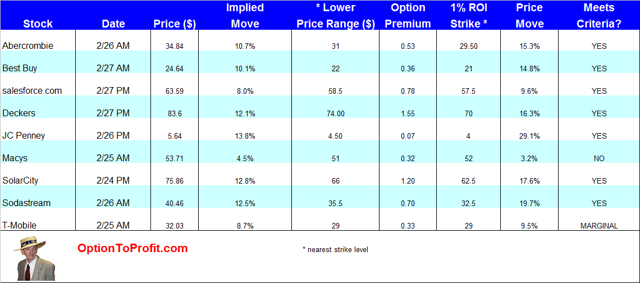 While most of the more meaningful companies in the S&P 500 have already reported earnings and new earnings season is barely 7 weeks away, there’s still time to profit from remaining earnings reports coming this week.
While most of the more meaningful companies in the S&P 500 have already reported earnings and new earnings season is barely 7 weeks away, there’s still time to profit from remaining earnings reports coming this week.
Whether a company’s shares respond to earnings by going lower or higher there is often opportunity to profit from either the good or the bad fortunes that they may endure as a result of their past performance and outlook for future fortunes.
As always, whenever I consider whether an earnings related trade is worth consideration I let the option market’s measure of “implied volatility” serve as a threshold in determining whether there is a satisfactory risk-reward proposition. That simple calculation provides an upper and lower price range in which any anticipated price movements will be contained.
Occasionally, for those selling options, whether as part of a covered call strategy or simply through the sale of puts, there may be an opportunity to achieve an acceptable premium even though it represents a share price that is outside of those bounds set by the option market.
This week there appear to be a number of stocks preparing to release their quarterly earnings that may warrant some attention as the reward may be well suited to the risk for some.
A number of the companies that I’ve highlighted are volatile in their own rights, but even more so when event driven, such as before earnings. While the implied volatilities may sometimes appear to be high, they are frequently borne out by past history and it would be injudicious to simply believe that such implied moves are outside the realm of probability.
While individuals can certainly set their own risk-reward parameters, I tend to look at a weekly 1% ROI as meeting my threshold on the reward side of the equation. I measure the degree of risk as whether I need to look above or below the implied volatility to achieve that desired return for what is anticipated to be a week’s investment.
Satisfactory risk exists when the strike price necessary to achieve the ROI is outside of the range predicted by the option market.
The coming week is replete with earnings reports and presents more companies than I usually find that satisfy the above criteria and are in companies that I usually already follow. Among the companies that I am considering this coming week are Abercrombie and Fitch (ANF), Best Buy (BBY), Deckers (DECK), JC Penney (JCP), Macys (M), salesforce.com (CRM), SolarCity (SCTY), Soda Stream (SODA) and T-Mobile (TMUS).
Since the basis of these trades is purely upon what may be considered an inefficiency between the option premiums and the implied volatility, I give no consideration to fundamental nor technical issues. However, my preference, when selling put contracts is to do so when shares have already been falling in price in advance of earnings. As the current week came to its end that included JC Penney, SolarCity, Deckers and Best Buy, although the coming week may define other possibilities.
For those not having sold put contracts in the past, one caveat when considering such trades, is that the investor must be prepared to own the shares if assigned or to manage the options contract, such as rolling it forward, if assignment appears inevitable.
 The table may be used as a guide for determining which of these selected companies meet the risk-reward parameters that an individual sets, understanding that re-assessments need to be made as prices and, therefore, strike prices and their premiums may change.
The table may be used as a guide for determining which of these selected companies meet the risk-reward parameters that an individual sets, understanding that re-assessments need to be made as prices and, therefore, strike prices and their premiums may change.
While the list can be used on a prospective basis in anticipation of an earnings related move there may also be occasion to consider the sale of puts following earnings in those cases where shares have reacted in a decidedly negative fashion to earnings or to guidance.
While some believe in hitting someone when they’re already down, there can be much more satisfaction gained in giving them support in their effort to rise again. Inherently the sale of a put is a statement of bullish sentiment and there may be opportunity to make that expression a profitable one as the response of many when knocked down is to get back up again.
Whether prospective or reactive, there is always opportunity when big movements are anticipated, but not fully realized.
And if they are realized? Think of it as simply more opportunity for opportunity.
